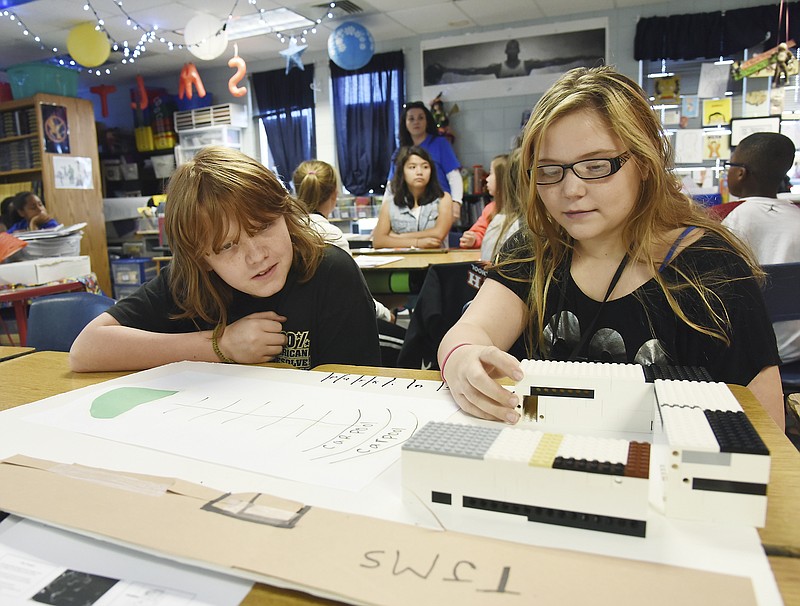Overcrowded classrooms have been on the minds of many Jefferson City School District officials.
However, at the end of the day, it's an issue that directly affects the student body, which is why one class set out to find a short-term solution.
Jeni DeFeo's sixth-grade contemporary issues class at Thomas Jefferson Middle School decided to take on its school's overcrowding issue.
The school is near capacity for the sixth-graders it has now. Next year, 75 additional sixth-grade students will be added to the mix, bumping the grade size up to 451 students by 2016-17.
At this juncture, the school has nowhere to put them, DeFeo said, so something has to be done.
The students chose the issue on their own after watching a news broadcast on
overcrowding that hit home for many of the students who said it was also affecting them.
"It really hit me," sixth-grader Emma Sellers said. "Our community is growing so fast. We need to take care of it, because we're here to learn."
DeFeo said the class is a hands-on approach for tackling contemporary issues. Instead of asking what someone else will do to fix it, they're taking on the problem themselves.
"I've told them that you can't complain about an issue unless you're part of the solution," DeFeo said.
The class was originally split into three groups.
One group suggested redrawing the boundary lines, another was going to come up with a "sky's the limit" plan without a set budget and another was going to use the school's current space, said sixth-grader Colton Sheehan.
After interviewing several district officials, they realized there's no way a school could have a limitless budget, so that idea was axed, he said.
They were also told redistricting couldn't be done unless a new school was built or additions were added onto the existing building.
The students knew building a new school was outside of their short-term timeline, so they couldn't redistrict.
So they were left with two realistic options.
The school could better use its current space or it could purchase temporary trailers. The class split into two groups to examine both options.
The "no change" group that wanted to reorganize how certain building spaces were used spoke with the financial director at JCPS to budget how much it costs to pay a sixth-grade team of four teachers versus two teachers.
A full sixth-grade team of four teachers and about 115 students costs about $500,000, including supplies. A "mini-team" of two teachers and about 55 students costs about $250,000.
Both are options the school could consider in wake of the growing sixth-grade population.
The students identified spaces that could be used as classrooms, including some basement space and computer labs that could be broken into two classrooms.
If the school worked within its own footprint, it could potentially add four classrooms, which would reorganize about six rooms in the building. The students also identified which walls could be taken down or built to create those classrooms.
The team that opted for temporary trailers budgeted the school would need three 24-by-68-foot trailers that could each host two classes.
The classrooms' square footage would be approximately 50 square feet less than the recommended space, so the students suggested no more than 25 students should be in each of those classrooms.
One new trailer costs between $80,000 and $85,000; an extra $25,000 would be needed for electricity hookups and steps or ramps.
The total budget would be between $352,000 and $450,000, the students determined.
They also looked at building codes, including issues regarding bathrooms for the trailers, how far the trailers have to be from the building and where they were permitted to put them.
The students measured three spots at the school's side parking lot, which would occupy 16 of the parking spaces.
All the students agreed schools are expensive and everything costs a lot more than they expected.
Cody Elliott said he learned every square foot of a school costs $200, factoring in all the supplies. However, even though it's expensive, it's something that needs to be addressed.
"It's a problem now, and it's going to be an even bigger problem in the years that come," Elliott said. "So we thought looking at overcrowding was the best solution."
The students presented their findings Thursday to Superintendent Larry Linthacum.
Linthacum said he was impressed by the students' plans. He said the plan he would most likely pick was to reorganize the school so it's better using the current space.
"It's a reminder for us that if there's any wasted space, then it's part of stewardship to use it better," Linthacum said. "From a sixth-grade prospective, it was really interesting."

